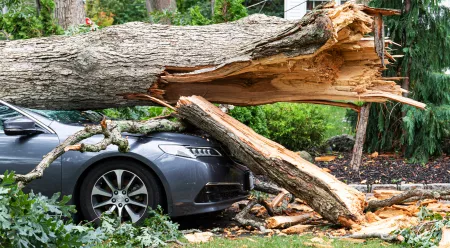There is something undeniably special about the winter months: the air is crisp, the scenery is lovely, and people are cheerful, especially around the holidays.
But, as some of you may know, a single night of severe weather can turn your winter wonderland into a frigid nightmare. Substantial snowstorms, hailstorms and cold temperatures can severely damage your property. Failing to take the correct preventative measures can lead to thousands of dollars worth of damage, and if you don't have the right home insurance coverage, you may have to pay for these expenses out of pocket.
If you'd like to avoid winter-related damage from occurring, you need to learn how to winterize your home. But, if this is your first winter in Canada or you recently purchased your first new home, you may not know how to winterize a house yet.
START A QUOTE
Thankfully, our team has put together a fantastic winterize house checklist that you can use to safeguard your property and belongings over the winter months.
What does the term "winterize house" mean?
Simply put, winterizing a house is the act of modifying particular objects or features in order to protect them from the elements or freezing temperatures.
Canadian homeowners use various winterizing techniques depending on the following:
- Location of the property
- The severity of weather conditions (average temperature, average snowfall, the likelihood of hail, etc.)
- Type of property (detached home, cottage, etc.)
Why should you winterize your home in Canada?
There are numerous reasons why you should spend time winterizing your home in Canada.
For starters, winterizing makes the interior of your home more comfortable for you, your family and guests. Additionally, winterizing your home protects certain property features and can prevent legal issues from arising (more on that below).
Lastly, winterizing your property can help you save on home insurance. Although there aren't any direct discounts related to winterizing your property, doing this lowers the risk of an issue occurring, giving you the flexibility to increase your home insurance deductible. Increasing your deductible reduces your monthly insurance payments, allowing you to save money over time.
Winterize home 101: tips and tricks to try this year
Here's an in-depth list of tips and tricks that you can utilize the next time you winterize your home:
Maintain your gutters
If you're planning on winterizing your home, the first thing that you should do is clean your gutters. Gutters are an integral part of the roofing system, as they allow excess water to flow away from your home. However, if your gutters are full of leaves, sticks or debris, they won't function properly.
Failing to clean your gutters sufficiently can lead to a variety of issues; for instance, if your gutters are clogged, they will likely overflow when the snow begins to melt. If the water from the melted now can't flow freely, it can potentially run down the side of your home or make its way into your home via cracks. This can lead to water damage in and outside of your home.
Furthermore, clogged gutters can also cause large icicles to form. Not only do icicles weigh down your gutters, but they can also lead to a serious injury down the line.
As an example, if your neighbour walks around the side of your home and is hurt by a falling icicle, you would be responsible for covering injury-related expenses (due to the fact that the incident occurred on your property).
If you don't have liability insurance, you'll have to cover these costs by yourself.
Bonus tip - Winterizing a cottage
Do you own a cottage or vacation property? If so, you should make sure that your cottage's gutters are spick and span before the cold weather rolls around. Most families don't visit their cottages as often in the winter, so you need to take extra care throughout the winterizing process, especially if you don’t have seasonal property insurance (which we highly recommend that you look into).
For more information on how to winterize a cottage, feel free to click here.
Set your ceiling fan clockwise
Although this tip may sound odd, it can help you keep your home warm and cozy over the winter season.
Setting your ceiling fan clockwise alters the airflow in your home. For instance, setting your fan counterclockwise pushes warm air up (which is ideal during the summer months), and setting your fan clockwise pushes warm air down.
Pushing the warm air down makes the overall temperature in your home more comfortable and can potentially help prevent pipes from freezing.
Best of all, this tip costs absolutely nothing to try (as long as you already have a ceiling fan installed in your home).
Seal your windows with weatherized tape
If your home is drafty, the culprit is most likely your windows. Over time, window seals can loosen, which allows cold air to enter your home. This makes certain rooms practically unbearable to be without a warm sweater.
Thankfully, there's a simple way to combat this issue: using weatherized tape.
Weatherized tape is a unique tool that you can use to reseal your windows. Weatherized tape utilizes a specialized material that allows it to retain an airtight seal for years.
Resealing your windows with weatherized tape helps prevent unwanted drafts and can even minimize moisture buildup in your home (which can prevent mold from forming).
Caulk large gaps
Unfortunately, not all problems can be fixed with weatherized tape. The next time you're dealing with a large gap or crack, call in the reinforcements: your caulking gun.
Caulking is an affordable and effective option for dealing with hefty gaps in:
- Windows
- Doors
- Exterior siding
Inspect your roof for damage or imperfections
Before finishing up the home-winterizing process, be sure to inspect your roof for damage.
Melting snow can potentially seep into cracks and openings that have formed on the roof. This can lead to severe issues like mold or interior flooding.
If you don't feel comfortable assessing your roof by yourself, you can hire a professional service to take care of the inspection for you.
Are you winterizing your home this year?
As you now know, winterizing is a simple yet effective way of protecting your property over the snowy season. So, what are you waiting for? It's time to start winterizing your home, Canada!



